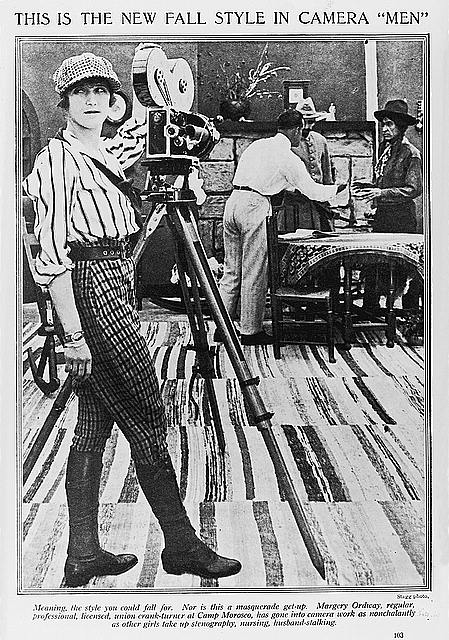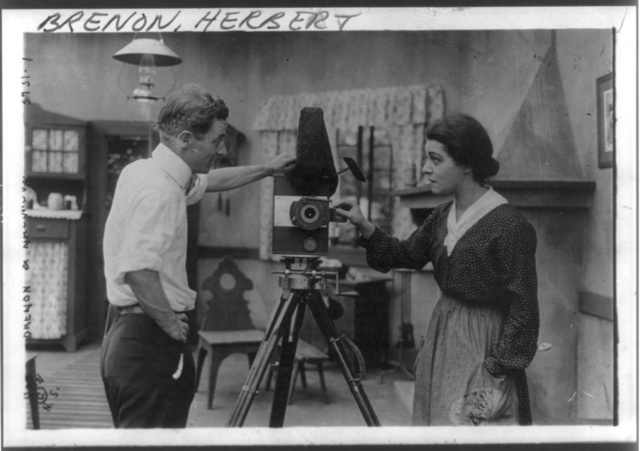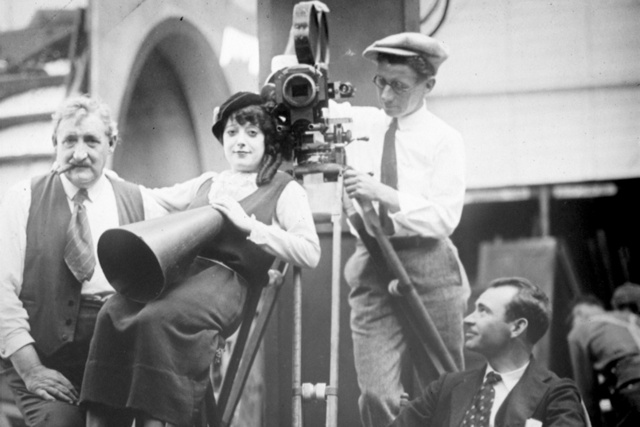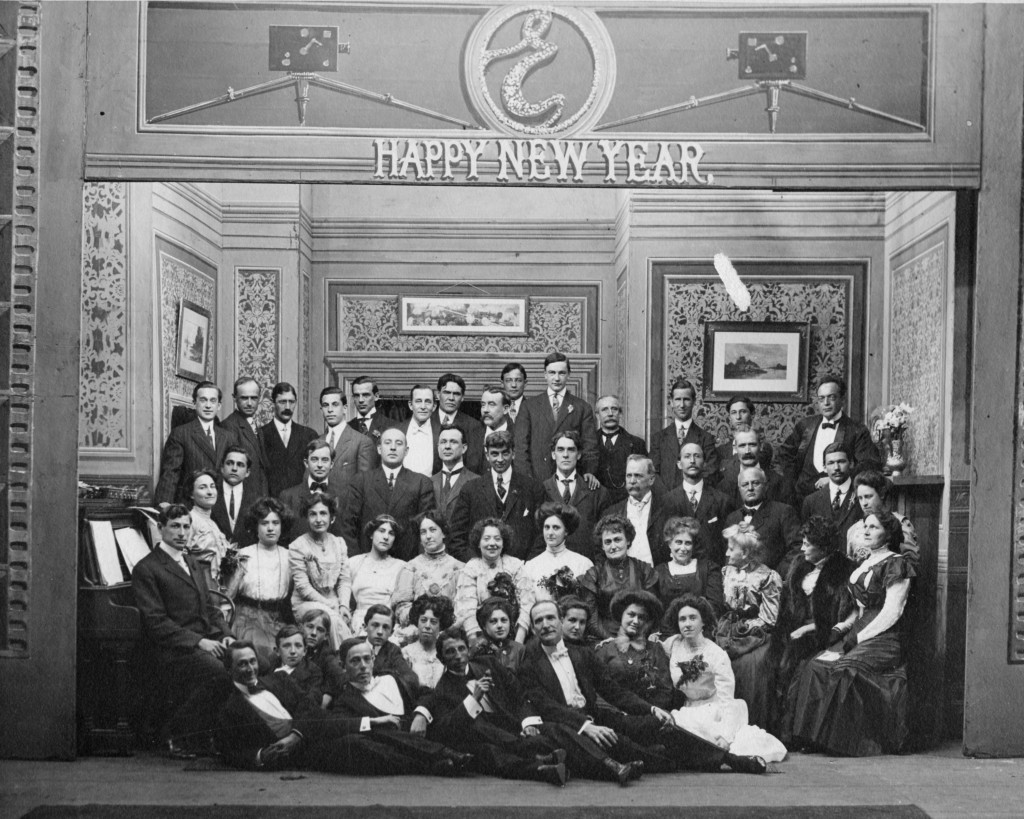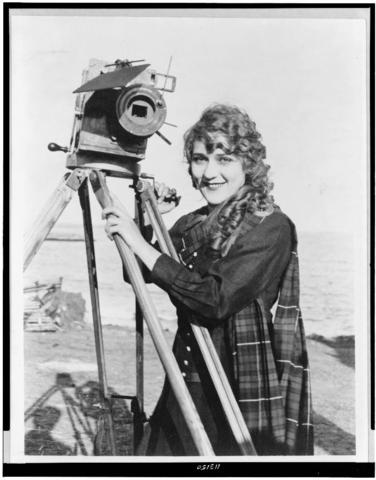
Mary Pickford with camera, c. 1916. Courtesy of Wikimedia Commons.
During the silent era there does not appear to have been much serious thought given to the question of why there might or might not be women working as motion picture camera operators. The handful who did do this work kept a very low profile, and, as a consequence, many in the commercial industry may have thought that there was just no such thing as a female camera operator at all. Even one of the most well-connected women in the industry couldn’t think of one. Powerful executive producer and screenwriter June Mathis, when asked in 1925 to reflect on women’s contributions said she could think of cases in which a woman worked as a cutter or a title writer but had yet to find a woman “turning a camera crank” (664). There were, however, a handful of women who despite the skepticism and even hostility they must have encountered on the set, did operate the heavy 35mm motion picture camera and mastered the new technology despite cultural expectations.
“Women with Cameras” vs. Women Camera Operators
While women as camera operators were rare, “women with cameras” was a publicity trend. If in 1916 silent actress Marie Doro took footage of Blanche Sweet with a motion picture camera, a gift from Charlie Chaplin, the New York Dramatic Mirror printed it as news (22). A bigger story, however, was not women and “little” 16mm cameras it was women with big 35mm cameras on the motion picture set. Yet not all women photographed with cameras were professional camera operators—some were actress directors or female producers, and here the photographic composition is telling. When actress-directors or female producers are photographed with cameras, either with men or alone in the frame, they are next to the motion picture camera. The female camera operator, however, is photographed behind the motion picture camera and in this she is a total novelty. In her strange new relation to the technological device this female aberration becomes a metaphor for the wondrous strangeness of motion picture photography itself.
Other Professional Camera Women
“How many of you have ever heard of a woman camera man?” begins the most in-depth of these stories, “The Only Camera Woman” (59). The Picture Play Magazine writer’s story angle is the attempt to correct incorrect assumptions about women’s technological abilities that the story attributes to the 1916 reader. Although the author byline is the gender inspecific A.J. Dixon the contemporary reader may assume that the writer is male from remarks made about the interview-shy “Miss Davison” as well as from an easy familiarity with men on the Astor Company set—director Al Ray and veteran cameraman Harry Fischbeck. Part of the writer’s approach is to make a joke about the expectation of female incompetence, all the better to turn the tables on the reader. The writer has imagined footage out-of-focus and either over or under-exposed negative. Before arriving on the set she wants to know from the two men about the camera woman’s technological skill, a segue into questions that give the writer a chance to display technological knowledge. “And does Miss Davison understand all about trick photography?” the writer asks (61). The writer is assured that she does triple exposure as well as double exposure (61). Davison then explains to the writer that she started with a Graflax still camera because it is easier to master than the motion picture camera because there is “no crank to turn” (62). But it is the professional Fischbeck, not Davison, who gets to explain the technique of one-crank motion animation produced with the hand crank on the side of the camera which he says is turned and stopped while the pose is changed, then turned and stopped again. Cameraman Fischbeck, continuing to testify to Grace Davison’s competence hands the fan magazine writer a strip of Eastman Kodak film negative which turns out to be Davison’s own experimental footage shot with the “one-crank motion” technique he has explained. The fascinated writer sees from the “little pictures that looked like ping-pongs” that Davison has taken an image of herself against black velvet using a mirror and reflector (64). Thus the “new and startling” woman camera operator advances a metaphor for the “new and startling” phenomenon of motion pictures (65).
In addition, the female camera operator’s looks are “startling.” In October, 1916, Photoplay featured a full page photo of camera woman Margery Ordway wearing a checked cap, striped blouse, and checked puttees. The caption below attempts to make light humor out of the gender switch: “This is the New Fall Style in Camera ‘Men’” (103). The quirky unconventionality of her outfit confirms the atypicality of women on this job. The gender-unspecified writer A.J. Dixon describes Grace Davison’s outfit similarly. What she calls her “camera dress” is a checked suit with a matching cap (61). The dress goes with the oddity of the terms “grinding” or “cranking” used to in the article to describe camerawork, slyly invoking the double meaning of the slang “crank” for operator without exactly saying that a woman behind a camera is bad-tempered.
Francelia Billington: From Film Actress to Camera Operator and Back
In a 1914 Photoplay article based on an interview with “camera operator” Francelia Billington the motion picture actress herself comments on the double fascination of the strange machine and a woman operating the mechanical wonder: “I suppose that it is still a novelty to see a girl more interested in a mechanical problem than in make-up” (59). Like Davison, Billington says that she started with the still camera at a young age and moved up to the motion picture camera although she says that her interest in photography did not mean that she was interested in popular films. Katherine Synon’s interview finds Francelia Billington on the Los Angeles set of the Reliance-Majestic Studio “assisting” director W. C. Cabanne. She is effectively doing the work of the “cameraman” or what would later be credited as “photography by,” described as “turning a crank as she keeps close watch on the scene that a group of players are enacting” (n.p.) In 1914, however, Billington’s work is not taken so seriously and the reference to her “double role of actress and camera operator” suggests that she is a lucky cameraman stand-in who helps out with the camera operation when she isn’t acting (n.p.)
Considering the organization of work on the set, one can see from this still taken from around the same time at the Edison Studio that jobs are already gender-hierarchized and one imagines the difficulty with which Billington moved back and forth across the invisible line between the all-male camera department and the dramatic scene. Like Davison, Billington says that she began as an actress but preferred camera work. However, the year of the interview must have been her last opportunity. The Reliance-Majestic Studio was new on the West coast under director-in-chief D.W. Griffith and he had big plans that did not include a woman camera operator.
Francelia Billington’s career trajectory, summarized in William M. Drew in “More Than Just a Pretty Face,” gets a slow start by association with an aborted 1915 project written by Nell Shipman, but picks up soon after. She was prolific as an actress at American Film Co. and Universal Pictures beginning around 1916-17 and even though she no longer worked with cameras she was featured in Movieland Notes working, like a mechanic, on her car.
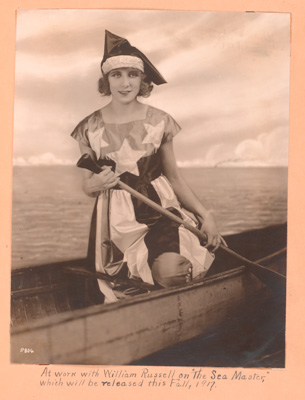
Francelia Billington, The Sea Master (American Film Co., 1917). Courtesy of the New York Public Library.
The high point in her career was a co-starring role in director Erich von Stroheim’s Blind Husbands (1919). But it is down hill for Billington in the 1920s, with parts in western and adventure genre films and an appearance in one sound film before she died in 1934. Grace Davison’s career similarly accelerates once she resigns herself to acting after 1916, but like others she also took advantage of the 1917–1918 window of opportunity for independent production and started “her own” producing company. See Women’s Production and Pre-Production Companies. A note in the American Film Catalog refers to actress Davison as having started the company in order to produce Wives of Men (1918), directed and written by John M. Stahl. While Harry Fischbeck (as Fishbeck) gets the credit for photography, Davison is credited as part of the cast in publicity and reviews but not as producer (Hanson, 1050). After producing Wives of Men she took one or two acting roles per year with independent productions until 1922.
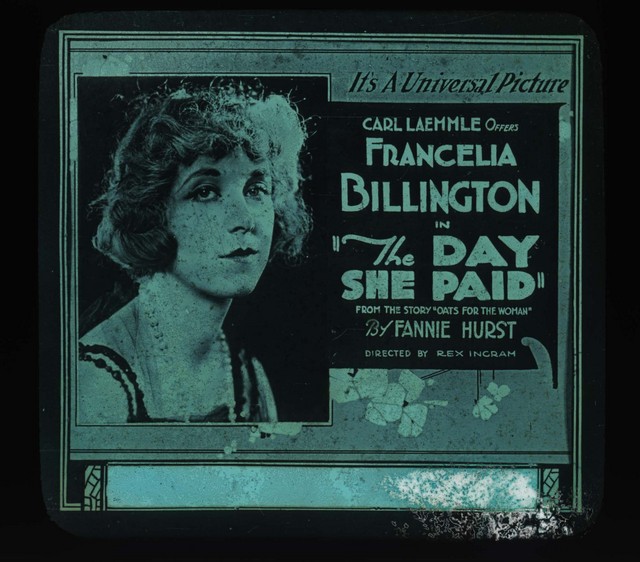
Lantern slide, Frencelia Billington, The Day She Paid (Universal, 1919). Courtesy of the Museum of the Moving Image.
The female camera operator was a phenomenon of the first decade which explains why in 1925 Mathis had never seen nor heard of one. It was not until the 1970s when Anthony Slide began to discover women directors in the silent era that camera operators were also brought to our attention. In his first book he refers to Grace Davison and Margery Ordway, having found them in the fan magazines referenced here, and briefly mentions Dorothy Dunn who he says was part of a “corps of cameramen” working at the Universal Animated Weekly (Slide 1974, 168). Dunn confirms the pattern of women beginning as actresses before they take up cameras, but unlike Davison and Billington who give up camera work for acting, Dunn gives up acting, becoming the “only woman staff photographer,” according to the Moving Picture World (1609). In his later book Slide mentions Dunn, Davison, and Ordway and adds Louise Lowell who worked for Fox News in 1920 (1996, 5-6). But the trope of “the first” or “the only” continues to lure us and more recently Suzy Groves discovers Katherine R. Bleecker as the “earliest professional moving camera woman” (qtd. in Krasilovsky 1997, xxi). While the New York Times covers Bleecker in 1915 and Photoplay discovers Billington in 1914, the difference between the kind of work the two undertook is more important than the year between them. While Billington had some opportunities to shoot motion picture fiction shorts, Bleecker wrote, directed and photographed scenarios set in New York prisons, casting inmates as themselves, and thus should also be understood as pioneering what we today call documentary fiction.
See also: Angela Murray Gibson

